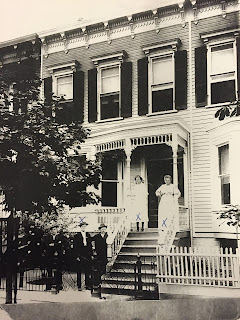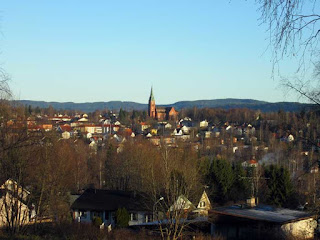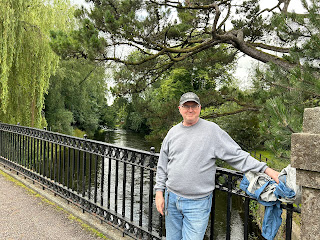My research strategy over the past several months has been to work through the records directly back from the present-day relatives as far back in time as I can, documenting the names, dates, and major lifetime events in my direct family. Then, once I've gone back as far as I can, I start with those distant ancestors and move forward in time, looking beyond immedate ancestors to include all of their children, those children's children, and so on. In this way I work my way back toward the present. The records from Ireland are, in my humble opinion, so far pretty nearly hopeless. Problems include privacy laws that cut off access to most of the records of the 20th Century; document losses in the Irish Civil War; the fact that there are very, very few records available for “normal” folk prior to the mid 1800's; and finally just the quality and availability of those records that do survive all make this a very difficult task. The Swedish records contrast starkly with this, and, as a result, that's where I've had the most success. For this blog post, I thought I'd begin sharing a little adventure involving the Swedish part of the family.
A few months ago I was working on the family of my great grandmother, Johanna Charlotta Barthelsson. My cousin Marcia Robbins just last week sent me a copy of a photo of Lottie and her two grown children (my grandfather Fred Johnson and his sister Wilma Westerlund). This is the first picture I've ever seen of her, and even though the photo is taken from a fair distance, it does a lot to bring her to life. In the picture you see below an anonymous annotator marked with X's the people that were known: Fred Johnson's on the left in the straw hat, his sister Wilma is in the middle at the top of the stairs, and next to her is their mother Lottie. The other two people in the picture are unidentified. I have no idea who the young sailor on the far left might be. I'm trying my best to resist the temptation to jump to the conclusion that the bearded man in the hat is Fred and Wilma's father Alfred. Lottie died in 1922 and the sailor's uniform looks exactly like those I saw on the Internet from World War I, so that gives a rough idea of the time frame. From the pose, I infer that this is Lottie's house, which would have been in Queens, NY.
Lottie is three generations back in time from me, and the people I'm going to tell you about are related to me by a husband and wife that are four generations before that. These are Thomas Bertilsson (1745-1821) and his wife Karin Persdotter (1748-1820). I'll try not to belabor the lines of descent, because I think that that will probably just confuse things, but Thomas and Karin are the point where these lineages converge.
Thomas and Karin had 7 children, 3 boys and 4 girls. I want to focus on one of the daughters, Annika Thomasdotter (1789-1855). She and her husband Lars Olsson (1796-1883) had only three children: a daughter Maret, and two sons, Olof and Thomas (1826-1903). The son Thomas, in turn, had four children with his wife Maret Persdotter (1820-1887): Per (who died at the age of 2), Gertrude, Jon, and Lars. The family lived in the parish of Fryksände in Värmland, the area in central Sweden near the Norwegian border that I've mentioned in an earlier post.
In the household record book for 1881-1882, we find the Thomas Larsson family living on the farmstead of Wadje in Fryksände parish. On the left-hand side of the page you can see their names, but the parish priest has put a line through all of them. On the far right-hand side you see why: under the column labelled “Flyttat” (meaning “moved”), all the members of the family have left Sweden for North America. The two brothers Jon and Lars left first in 1881, and then the parents and sister followed just over a year later.
This was the earliest record I'd found of a branch of the family that moved from Sweden to North America. But where in North America did they end up? To make a long story short, the family turns up living in Wright County, Minnesota, near the town of Buffalo. Somewhere along the way their names were Anglicized: Lars Thomasson became Louis Thompson, his brother Jon became John, and mother Maret became Mary. (Father Thomas and sister Gertrude didn't need a name change, I guess.) A brief history of the Louis Thompson family in the U.S. was published in a book entitled Buffalo: from trading post to star city. It seems that he didn't come directly to Buffalo, but first worked as a cook on a Mississippi riverboat. Remember, the Mississippi arises in Minnesota and separates the twin cities of Minneapolis and St. Paul. Later he and his brother settled on adjacent 40 acre farms north of Buffalo. Here's a map showing the location of their homesteads (colored in blue in the northwest corner of the map) and, below that, an aerial image from Google Maps showing it today. I tried to get an image from Google's camera car, but apparently it hasn't taken images down that road quite yet.Between records that were available on the Internet and in the book on Buffalo, I was able to gather a fair amount of information. At that point, though, there was still an element of doubt as to whether Louis and John corresponded to Lars and Jon. So I needed more corroborating evidence.
As it turned out, I was making these discoveries and coming to some preliminary conclusions just about two weeks before I was scheduled to head off to our annual professional meeting, that of the Entomological Society of America. (For those that might not know, I study insects for a living.) This convention rotates around the country: the year before it was in Portland, Oregon; other cities have included Louisville, Cincinnati, San Diego, Fort Lauderdale, etc., etc. This year though, the meeting was being held in Minneapolis. A quick online query told me that Buffalo, Minnesota was only about 40 miles away from Minneapolis. So then I knew what I had to do: rent a car and head west to check out Buffalo!
My goals were, I admit, a little sketchy. I knew that Louis Thompson, his wife, and his parents were buried in the Zion Lutheran Cemetery. So that was a stop for sure. I'd also tried to look up obituaries published in local papers, but I couldn't find any that were accessible online. So, my second goal was to stop in at the local library to look through their microfilm copies of the local paper, the Wright County Journal-Press.
I suppose I should count my blessings. I was travelling in Minnesota in November. By all rights there could have been two feet of snow on the ground. Thankfully, that wasn't the case, but it was a miserable day to go exploring. Temperature in the low 40's, rain, and a strong wind. After a few wrong turns getting out of downtown Minneapolis and avoiding the rush hour traffic, I got to Buffalo sometime around 9 a.m. Buffalo's a small town, population 15,453 in 2010, located on the shore of Buffalo Lake. It seems that despite the town's adoption of the bison as it's symbol (they're all over town!), it's actually named for the buffalo carp that were so common in the lake.The Zion Lutheran Cemetery is located a few miles south of town, and it's a small graveyard. I hadn't bothered to write ahead to find out any details of burial plots or the like, I was just planning to wander around to see what I could find. I wasn't planning on that kind of weather, though. My targets were Louis and Karen Thompson, Louis's parents who would have had the surname Larson, and Louis's sister Gertrude. Gertrude had married a man named Andrew Olson. Therefore, I was on the lookout for monuments with the names Thompson, Larson, or Olson.
I parked the car in the graveyard and climbed out into the wind, rain, and cold. Almost immediately a pair of monuments caught my eye, one with the name Thompson, the other Olson. Could I be so lucky? Not really: neither stone had any other names or dates on them, and there were no markers around them at all.Disappointed at that, I began to try to do a thorough search of the graveyard, starting from one end and going to the other. As I said, it's a small cemetery. I did find the graves of one part of the family, Louis's son Walter and Walter's wife Florence. Other than that, I found nothing. Then the battery on my phone gave out, and I couldn't take any more pictures. Besides that, my shoes were soaked from walking in the wet grass. It seemed that the time had come to do my library work, dry out, and warm up.
I did have some dates to work with in searching through the old newspaper records, so that turned out to be pretty successful. The obituaries confirmed that Louis and John were born in Värmland and their dates of birth matched those I'd found from the Swedish records. So I was feeling a lot better that Louis was really Lars, and that these really were relatives. I spent a few hours looking through the microfilms and making copies of pages with family history. I stumbled on one article about a surprise birthday party for Louis's 40th (did I mention that Buffalo is a small town?). The staff in the Buffalo library were very friendly and helpful, somewhat amused at having a visitor from central Ohio, and interested that I apparently had family in the area.
After drying out shoes and socks (I won't go into the details) and recharging my phone fully, I decided to take another shot at looking for the graves in the Zion cemetery. It was quite possible that there were no gravestones to be found at all. In my searches through Old St. Mary's Cemetery in Little Falls I did ask for information about the location of graves of family members. I was directed to an area where there were several people buried, but there were markers for only a small number of them. So, I was prepared to not find anything.
I went back to look at those two monuments that I'd found the very first thing: one with the name Olson and one with the name Thompson. I mentioned that it was a windy day in mid November. As you might be able to see in the pictures all the leaves had fallen from the trees and the wind hand basically blown the ground clear of them. But not entirely clear, and then I noticed something a bit odd: there were a number of small clusters of wet leaves in small depressions and those clusters seemed to form a straight line. I swept away the leaves, pushed and kicked the overgrown grass back, picked off the earthworms, and there they were. I found markers for the entire family. They were fairly small, about 4x10 inches, and they'd sunk into the ground several inches. This made the depressions in which the leaves collected. The first stone I found was for the patriarch of the family, Thomas Larson. My hands were shaking too much from the cold to make it a good picture, so I've shown you here the stone for Louis.
I didn't find the graves for brother John Thompson. From his obituary I learned that he'd left the Lutheran congregation for the Covenant church and was buried in the Swedish Mission cemetery. I'll have to make another trip to Minnesota – this time in the summer! - to track down that lead.There is more, but I think I'll save it for another post. I have all the material in hand, but I didn't want to make this one drag on to long. So look forward to more information about our Swedish family immigrating to the U.S. The title of this post “Unto a Good Land” is actually the English title of the second book of a four-part series written by the Swedish author Vilhelm Moberg. The Swedish title is Invandrarna. This tetralogy – sometimes called the Emigrant suite – tells the story of a fictional family leaving Sweden and settling in Minnesota in 1850. I've just finished the second book in the series and starting the third tonight. The first two books (the Emigrants and Unto a Good Land) were the basis of a 1971 movie, The Emigrants, that starred Max von Sydow and Liv Ullman. It was nominated for the Best Foreign Film and, the following year, for four other Oscars including Best Picture, Best Director, and Best Actress. In the near future, I plan to write up some new posts talking about some of our Swedish immigrants to North America.















No comments:
Post a Comment